No matter how many times I see them, the sight of a white pelican or bald eagle will make my day. I’ll happily hike or paddle for hours on just the prospect of a thrilling Florida wildlife viewing.
Winter is the best of times because migrating birds are here and the dry season concentrates the wildlife.
Florida wildlife is all over the state; even in urban Miami, you’ll see dolphins in Biscayne Bay or an occasional crocodile.
There are a few reliably great places to spot wildlife, however, that I will return to as often as I can.

These are my favorites. This list isn’t comprehensive, but all of these locations have a record of outstanding wildlife viewing over a long period of time. Several make it so easy, you barely have to leave your car. Some offer miles of hiking into the wild.
Florida wildlife in South Florida
Bird Rookery Swamp in Naples
Few South Florida hiking or biking trails rival this 12-mile-long trail near Naples for scenery and wildlife. It’s free and deserves to be known outside the Naples area.

Bird Rookery Swamp is a birding hot spot that is full of wildlife. We saw dozens of gators, some sunning on the pathway so close we gingerly walked around them, some in ponds alongside the trail, including one pond with 13 baby gators about 18 inches long.
Visitors have seen deer, bobcats, otters, black bear and even Florida panthers. (This is prime panther habitat.) Most of the trail is lined with forested wetland dominated by exquisite bald cypress and red maples trees.
Admission is free.
CREW Bird Rookery Swamp Trail
1295 Shady Hollow Blvd. West, Naples.
239-657-2253.
Map to Crew Bird Rookery Swamp Trail
Shark Valley in Everglades National Park west of Miami
One of the best ways to see Florida’s Everglades is via the Shark Valley entrance off the Tamiami Trail. It’s home to a terrific bike trail and abundant wildlife.
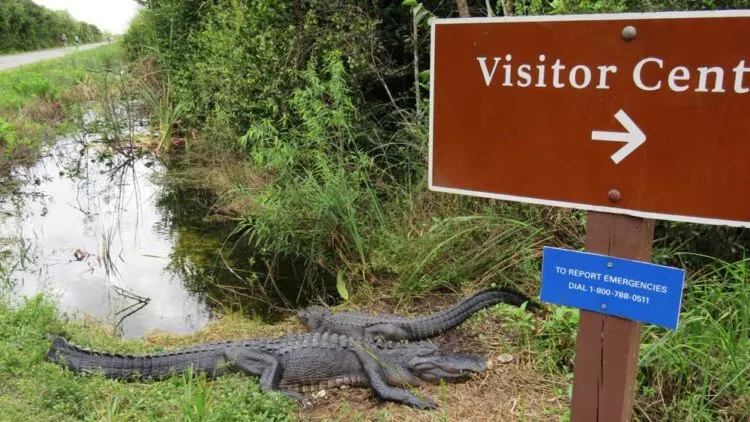
At Shark Valley, the alligators and birds that line that trail in winter will amaze. The wildlife seems used to humans and goes about its business just steps from visitors.
Here, you may have to walk around the alligators, who sometimes sun themselves with body parts extending onto the trail. In the first mile of the trail on a sunny winter day, you’re likely to count a dozens of alligators, plus myriad birds, often right next to the gators.
As the flow of water through the Everglades has been improved through a massive multi-year restoration project, wildlife in some places you reach from the Homestead entrance has diminished as the animals have spread out. That hasn’t happened at Shark Valley, where wildlife sightings have been stronger than ever in the 2023-24 winter.
Admission to Everglades National Park is $35 per car.
Shark Valley
36000 SW 8th St.
Miami
Three manmade wetlands in Palm Beach County
Urban dwellers from Broward and Palm Beach County have the good fortune to have these wildlife hotspots so accessible to so many. Each is a boardwalk over a manmade wetlands system designed to filter treated wastewater. The water depth and vegetation is managed to create ideal conditions for wildlife. And they show their appreciation.
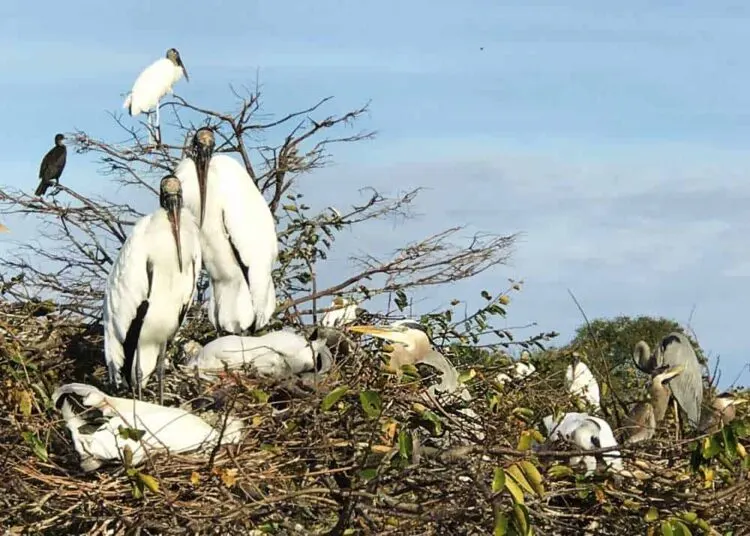
Located close to the Everglades in the western-most areas of Palm Beach County, each of these sites has become just as popular with birds and wildlife as with people.
My favorite is Wakodahatchee because dozens of wood storks (once a rare site in this area) build nests here in the spring on tree islands just yards off the boardwalk. The stork nests are joined by cormorants and great blue heron building nests. Observing the whole process over the winter to spring is a remarkable experience.
Green Cay Wetland, only minutes away, has a longer boardwalk and a bigger marsh, with bird life more spread out. But we’ve had some outstanding sightings here.
Wellington’s Peaceful Waters is not huge, but the birding can be tererific, with white pelicans soaring overhead and a flock of roseate spoonbills fishing the shallows as we gawked and snapped photos one winter day.
Admission to all three facilities is free.
Wakodahatchee Wetlands
Wakodahatchee Preserve
13026 Jog Road
Delray Beach
Green Cay Wetlands and Nature Center
12800 Hagen Ranch Road
Boynton Beach
(561) 966-7000
Wellington’s Peaceful Waters
11676 Pierson Road
Wellington, FL
561-791-4000

Florida wildlife in Central Florida
Orlando Wetlands, 20 minutes off I-95
Orlando Wetlands Park is off the beaten track, but it’s a must-stop for birders and wildlife fans. It’s home to over 100 roseate spoonbills, 1,700 alligators and 200 species of bird. What’s even better: A half-mile boardwalk opened last year providing great views of nesting birds in a cypress island.
Orlando Wetlands is yet another example of a manmade wetlands that wildlife loves. The park has 18 water-filled cells filled with the necessary plants to create three ecological communities: deep marsh, mixed marsh and hardwood swamp.
Admission is free.
Orlando Wetlands
25155 Wheeler Road
Christmas FL
Circle B Bar Reserve in Lakeland
If you don’t live near it, you probably don’t know about Circle B Bar Reserve, a Polk County park that is just as impressive as many of Florida’s state parks. (And Florida state parks are award-winners.)
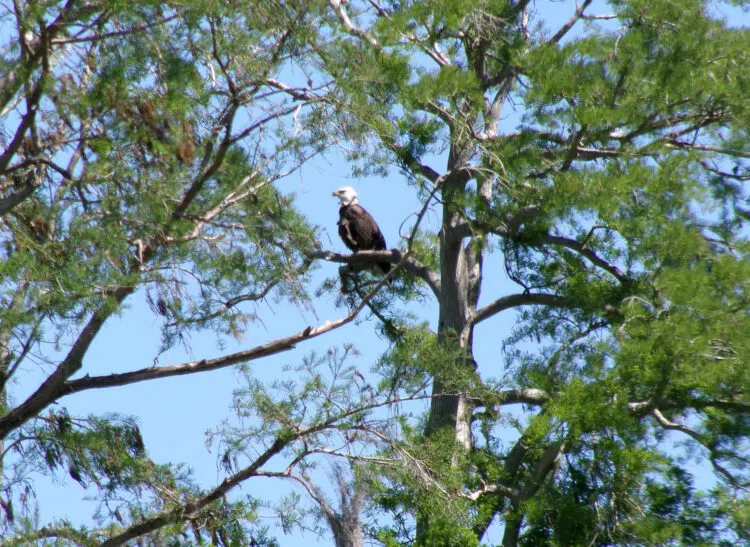
It is especially terrific for birding from fall through spring, when nature photographers flock here to capture images of the huge white pelicans, pink spoonbills, leggy sandhill cranes, iconic bald eagles and dozens of other birds. It’s also famous for its alligator residents, who have been stars of YouTube videos.
It’s a former cattle ranch (thus its name ) and is located in Lakeland, midway between Orlando and Tampa.
Admission is free.
Circle B Bar Reserve
4399 Winter Lake Road
Lakeland, FL
863-668-4673
Merritt Island National Wildlife Refuge in Titusville
This wildlife refuge is big, beautiful and full of birds. From bald eagles majestic in tall pine trees to friendly scrub jays only a few feet away, visiting here offers awe-inspiring experiences.
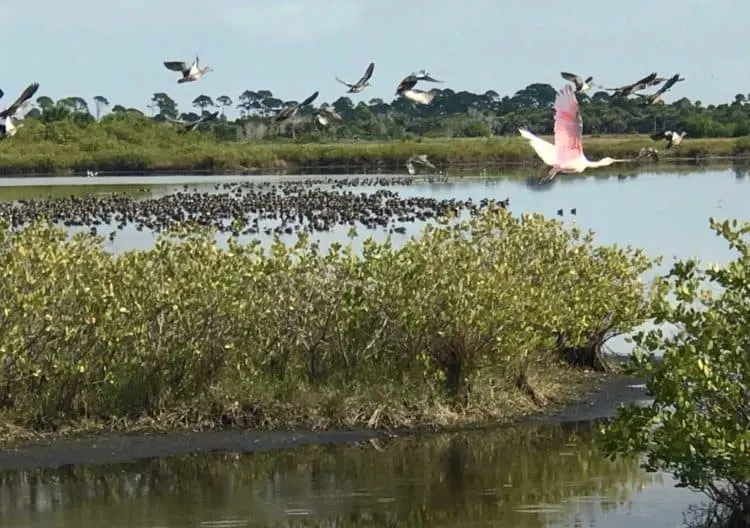
Blackpoint Wildlife Drive is the highlight of the refuge. It’s a 7.7 mile long, one-way one-lane dirt road through areas of the refuge where the water level is managed to benefit wildlife.
On winter weekends, it may be full of cars moving slowly and quietly. Cars work like “blinds” allowing visitors to see wildlife up close. When you get out, as people do where there are good views of birds in the wetlands, you are urged to move carefully and quietly without slamming car doors.
There are plenty of expert birders here. Several helped us spot and appreciate a few rarer species — the cinnamon teal and a northern pintail duck. For me, the exciting sight was the flock of hooded mergansers because of their preposterous Mohawk head feathers and ridiculous hoods.
Admission is $10 per car.
Merritt Island National Wildlife Refuge
1987 Scrub Jay Way #32782, Titusville, FL
(321) 861-0669
Florida wildlife in North Florida
Paynes Prairie Preserve in Micanopy
This Gainesville area state park is home to some of the most unusual wildlife you’ll find in Florida — bison and wild horses. The preserve is 21,000 acres with no roads across it, accessible only from its southern or northern end.
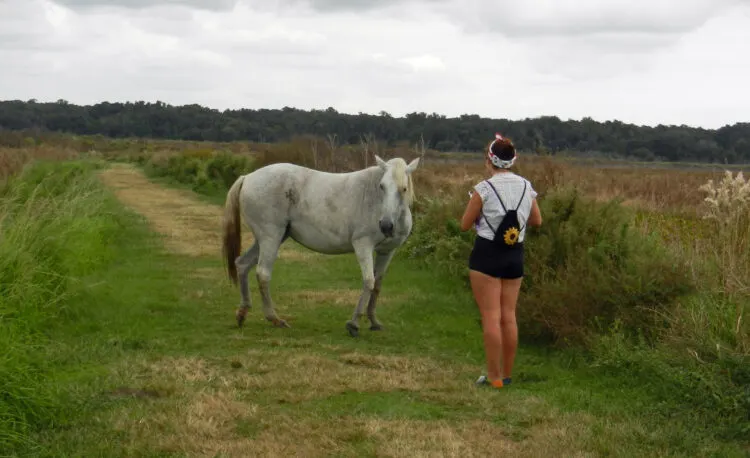
The wild horses at Paynes Prairie are descendants of those brought to Florida by the Spanish. They grazed on flowers and grasses in and along the trail we hiked on our visit.
Because the bison’s range once extended this far southeast, 10 bison from Oklahoma were introduced here in 1975. Today, there’s a herd of 50 to 70. We were not lucky enough to see bison, but walking the trails they are said to frequent, we found other evidence – bison patties, I guess you’d call them.
But there’s even more wildlife here, including many birds. In some years, huge flocks of migrating sandhill cranes winter here, and are occasionally joined by a few rare whooping cranes.
This park is in an area with many natural and historic attractions that are worth exploring. There is also great hiking and camping here.
Admission is $6 per vehicle.
Paynes Prairie Preserve
100 Savannah Blvd, Micanopy, FL 32667
352-545-6000
Florida wildlife in Tampa Bay area
Myakka River State Park in Sarasota
Myakka is one of the oldest and biggest state parks, a great place for seeing wildlife, from huge gators to hundreds of birds in winter. On our March visit, we saw flocks of roseate spoonbills, frequent sightings of limpkins, storks and all sorts of wading birds.
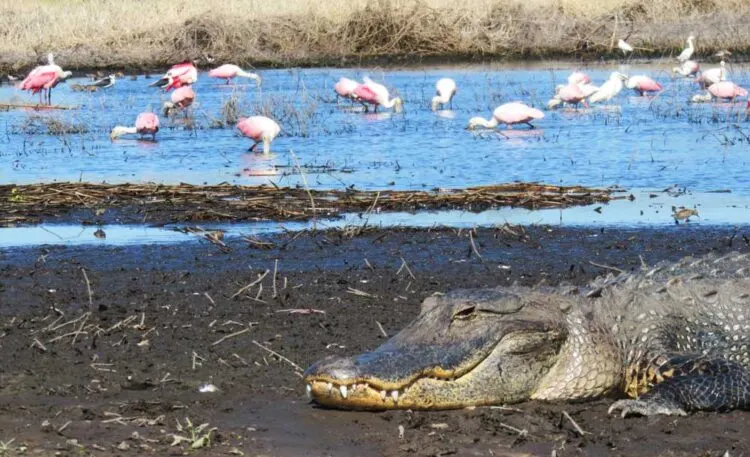
At the Birdwalk, a boardwalk extending into Upper Myakka Lake, friendly expert birders volunteer on winter mornings, locating birds in their scopes and helping visitors identify them.
At 37,000 acres, Myakka is one of Florida’s most complete outdoor experiences. There are log cabins, appealing camp sites, excellent kayaking, extensive hiking and good bike trails. It’s also a good spot for nature neophytes, who enjoy the boat ride and canopy walk.
Admission is $6 per vehicle.
Myakka River State Park from Florida Rambler
13208 State Rd 72
Sarasota, FL 34241
941-361-6511
Celery Fields in Sarasota
Outside Sarasota, just five minutes off I-75, a storm-water collection zone and former agricultural area has become an excellent habitat for birds and wildlife in the winter.
While the preserve is more than 300 acres, the most convenient place for wildlife viewing are the two boardwalk. One is on the south side of south side of Palmer Boulevard and the other on Raymond Road.
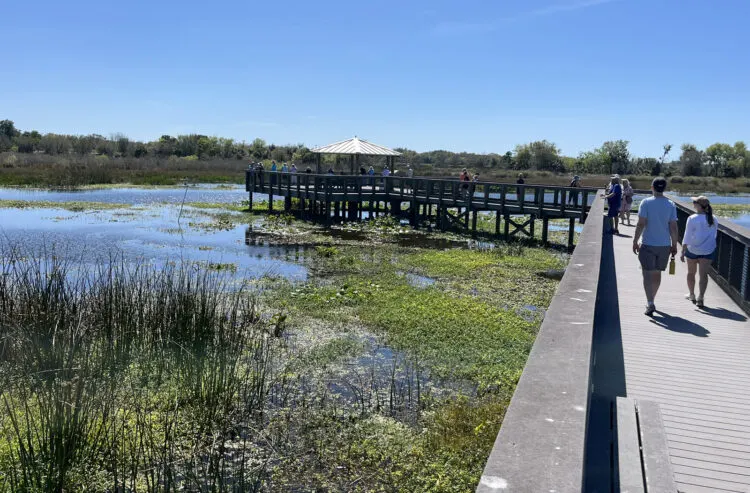
On a February day, we found lots to see from the boardwalk on Palmer Boulevard: roseate spoonbills, blue-winged teals, an alligator actively swimming through a group of birds. The longer we stayed, the more birds we spotted, and the friendly birders nearby were helpful in pointing out and identifying species. In the water, we saw fish (big tilapia, not a native species) and soft-shell turtles.
On the north side of Palmer Boulevard there are restrooms, water, picnic tables, more trails and fun-to-watch purple martin birdhouses.
The area was indeed used for growing celery from the 1920s until the county acquired it in 1995.
Admission is free.
The Celery Fields
6799 Palmer Boulevard, Sarasota, FL 34240
(941) 861-5000
More Florida wildlife hotspots
Have a favorite place? Please add it by making a comment. (Scroll to the bottom.)
The Great Florida Birding and Wildlife Trail is an excellent resource. Here’s more about using the GFBWT website.
There are other types of wildlife too.
Want to see manatees? We know just the spot: Where to see manatees in Florida waters: Try these 18 spots
Want to see fish and underwater creatures? Here are the best places to go snorkeling without a boat.
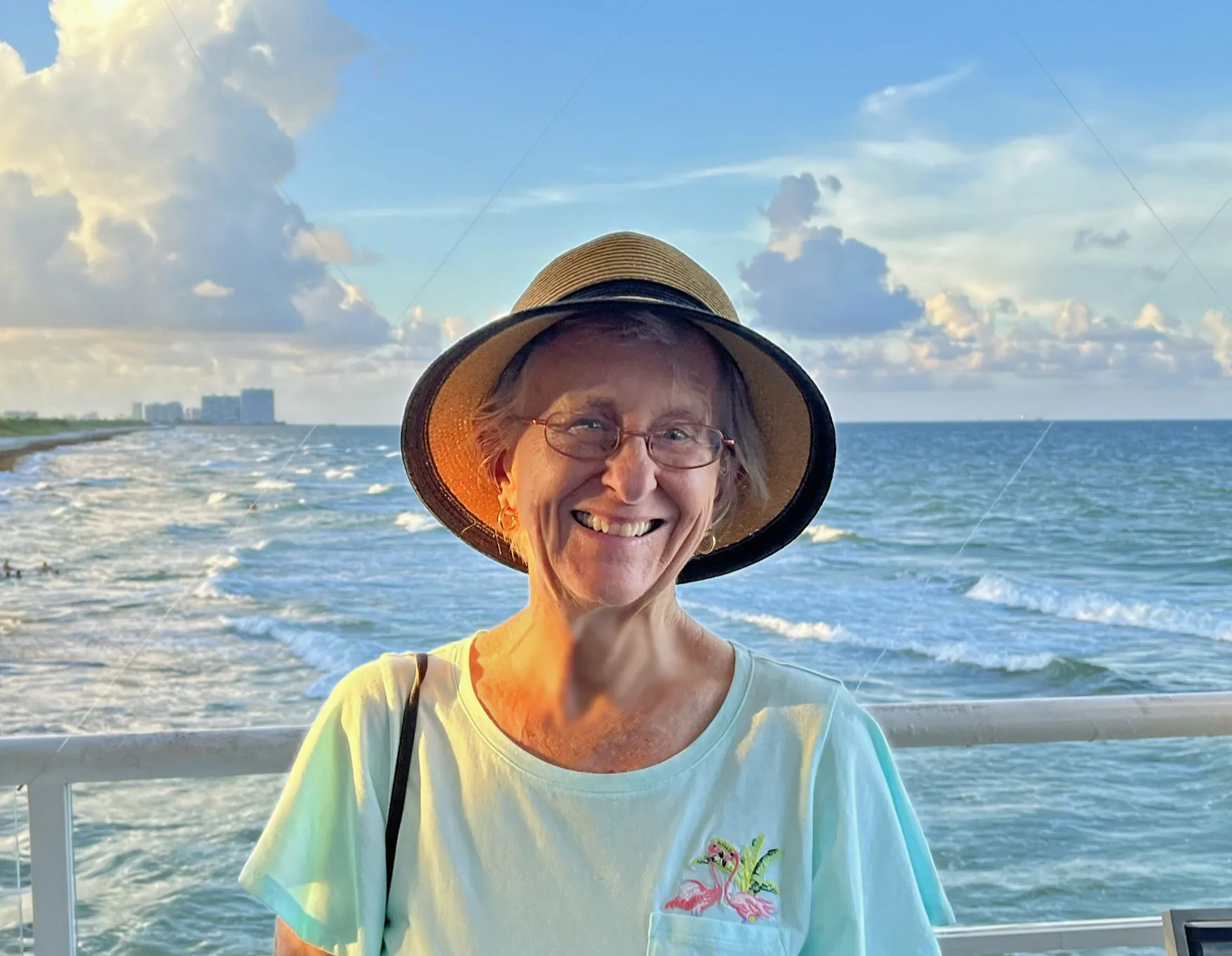
The author, Bonnie Gross, travels with her husband David Blasco, discovering off-the-beaten path places to hike, kayak, bike, swim and explore. Florida Rambler was founded in 2010 by Bonnie and fellow journalist Bob Rountree, two long-time Florida residents who have spent decades exploring the Florida outdoors. Their articles have been published in the Sun Sentinel, the Miami Herald, the Orlando Sentinel, The Guardian and Visit Florida.

penny pray
Saturday 3rd of February 2024
Bonnie,
I wouldn't bother recommending Viera Wetlands, as so much has changed there in the last several years. After one of the hurricanes that hit that area most of the Palm Trees and others that were great nesting areas close to the berm trails were destroyed and never replaced. Thus pushing the nesting birds to an island where it is difficult to see them without strong binocs.In addition they used to allow driving in like Black Point and that stopped after people ruined the roads after rainstorms and there was no money in their budget to fix the deeply rutted results. Viera has also been building out their "neighborhoods" so lots of construction and new homes take away any sense of "peacefulness" that used to surround this place. You are still welcome to park and walk in, but it's a long stroll with not as much to see now.
One place you did not mention is the Marjory Stoneman Douglas Preserve in far western Wellington on the edge of the Everglades. Off of Southern Blvd. on rural Flying Cow Rd., it has 2 entrances, a clean restroom at the northern one, paved walkways that allow bikes( the only one like it that does ), a Butterfly garden , a circular trail surrounding the whole area for horses, a tall tower to get a birds eye view and 2 boardwalks over the wetlands lakes. It is jammed on the weekends due to the number of families taking advantage of it's safe biking paths, so going during the week is much better.
My husband and I have been doing amateur Wildlife Photography in mostly South Florida for the past 22 years and the ones you mentioned are indeed wonderful and very popular. However, I disagree with you recommending areas where the gators are prevalent along and on the trails where you "just step around them". That is extremely dangerous and should be avoided at all costs. These are wild animals that can be very fast and little children look very much like some of their prey food.I know it's "exciting" for many people unfamiliar with their danger or especially their speed to see an alligator up close in the wild , but we won't go to any area that has them so close to our walking path. Assumptions can so quickly turn to tragedy.
We used to go into Grassy Waters in Palm Beach Gardens/West Palm on their perimeter berm/levee trails like Apoxee and Owahee years ago, but stopped for a few reasons...poor maintenance had allowed the plant growth to grow up and hide the area next to both the drainage canals and the ponds, thus narrowing the pathway and allowing huge gators to hide ,while in effect obscuring a lot of the open areas for safety and from viewing any of the birds. It's a long hike for sometimes little reward and with so many other closeby places with more to offer, we no longer feel safe there so don't go. Plus they have a very popular biking trail that rings the preserve and is accessible to the many communities that border Grassy, so dangerous for walkers in that regard too with speeding bikes and not much room to move out of the way.
There is a very nice boardwalk at the main location for Grassy Waters that leaves from their Visitors Center and it's wildlife exhibits/information desk , which takes you through old cypress/pine/palm forest, ponds and wetlands and then ends at a covered viewing spot for a grand view out over the large shallow wetlands that are actually the main drinking water source for the city of West Palm Beach.
Hope this helps answer your question as to more suggestions. I enjoy your Florida Rambler and we have used many of your suggestions to venture farther afield in Florida. I do have others for you personally as I don't want them to get so overun like the Wakodahatchee . Email me and I'm happy to share :-) Sincerely, Penny